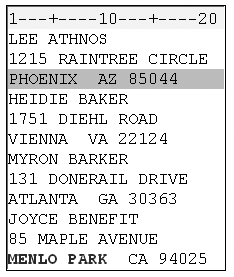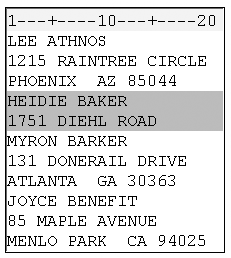Reading Multiple Records Sequentially
The Forward Slash (/) Line Pointer Control
Use the forward slash (/) line
pointer control to read multiple records sequentially. The / advances
the input pointer to the next record. The / line pointer control
moves the input pointer forward only. Note that it must be specified
after the instructions for reading the values in the current record.
The single INPUT statement
below reads the values for Lname and Fname in the first record, followed
by the values for Department and JobCode in the second record. Then
the value for Salary is read in the third record.
input Lname $ 1-8 Fname $ 10-15 /
Department $ 1-12 JobCode $ 15-19 /
Salary comma10.;Figure 20.2 Multiple Records Comprising Each Observation

Using the / Line Pointer Control
The raw data file Memdata
contains the mailing list of a professional organization. Here are
the steps for combining the information for each member into a single
observation.
-
As you write the instructions to read the values for Fname and Lname, notice that not all of the values for Lname begin in the same column. Use standard list input to read these values.
data perm.members; infile memdata truncover; input Fname $ Lname $TipUse the TRUNCOVER option in your INFILE statement so that SAS can read data for the variables until it reaches the end of the data line. Otherwise, your data will not be produced with the correct variables in the correct columns.Figure 20.3 Raw Data File Memdata
-
Now read the values for Address from the second record. The / line pointer control advances the input pointer to the next record. At this point the INPUT statement is incomplete, so you should not place a semicolon after the line pointer control.
data perm.members; infile memdata truncover; input Fname $ Lname $ /
Figure 20.4 Raw Data File Memdata
-
You can use column input to read the values in the next record as one variable that is named Address. Then add a line pointer control to move the input pointer to the next record.
data perm.members; infile memdata truncover; input Fname $ Lname $ / Address $ 1-20 /Figure 20.5 Line Pointer Control Advanced One Record
-
As you write the statements to read the values for City, notice that some of the values are longer than eight characters and contain embedded blanks. Also note that each value is followed by two consecutive blanks. To read these values, you should use modified list input with the ampersand (&) modifier.The values for State and the values for Zip do not begin in the same column. Therefore, you should use list input to read these values.
data perm.members; infile memdata truncover; input Fname $ Lname $ / Address $ 1-20 / City :& $10. State $ Zip $; run;Figure 20.6 Line Pointer Control Advanced Another Record
Sequential Processing of Multiple Records in the DATA Step
The values in the first
record are read, and the / line pointer control moves the input pointer
to the second record.
Figure 20.7 Reading the First Record of the First Observation

The values for Address
are read, and the second / line pointer control advances the input
pointer to the third record.
Figure 20.8 Reading the Second Record of the First Observation

The values for City,
State, and Zip are read. The INPUT statement is complete.
Figure 20.9 Reading the Third Record of the First Observation

The values in the program
data vector are written to the data set as the first observation.
Figure 20.10 The Program Data Vector and the SAS Data Set Perm.Members

Control returns to the
top of the DATA step. The variable values are reinitialized to missing.
Figure 20.11 Reinitializing the Variable Values to Missing

During the second iteration,
values for Fname and Lname are read beginning in column 1 of the fourth
record.
Figure 20.12 Reading the First Record of the Second Observation

The values for Address
are read. The / line pointer control advances the input pointer to
the fifth record.
Figure 20.13 Reading the Second Record of the Second Observation

The values for City,
State, and Zip are read. The INPUT statement is complete.
Figure 20.14 Reading the Third Record of the First Observation

The values in the program
data vector are written to the data set as the second observation.
Figure 20.15 The Program Data Vector and the SAS Data Set Perm.Members

After the data set is
complete, PROC PRINT output for Perm.Members shows that each observation
contains the complete information for one member.
proc print data=perm.members; run;
Figure 20.16 PROC PRINT Output of the Complete Perm.Members Data Set

The Number of Records per Observation
Note: A raw data file must contain
the same number of records for each observation.
Suppose there are only
two records for the second member. Remember, the INPUT statement is
set up to read three records.
data perm.members; infile memdata truncover; input Fname $ Lname $ / Address $ 1-20 / City :& $10. State $ Zip $;
Figure 20.17 Raw Data File Memdata

In this case, the second
member's name and address are read and assigned to corresponding variables.
Then the input pointer advances to the next record, as directed by
the INPUT statement, and the third member's name is read as a value
for City.
The INPUT statement
looks for a value for State and Zip, so the input pointer advances
to the next record and reads the member's address.
Before you write the
INPUT statement, check to see whether the raw data file contains the
same number of records for each observation. In this raw data file
there are now three records for each observation.
Figure 20.18 Verifying the Number of Records for Each Observation

Last updated: January 10, 2018
..................Content has been hidden....................
You can't read the all page of ebook, please click here login for view all page.
